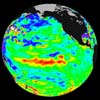|
Free Newsletters - Space News - Defense Alert - Environment Report - Energy Monitor |
| . |  |
. |
|
|
El Nino Holds The Reins On Global Rains
NASA and Japan's Tropical Rainfall Measuring Mission (TRMM) satellite has enabled scientists to look around the globe and determine where the year-to-year changes in rainfall are greatest. Recently, scientists found that the El Nino-Southern Oscillation is the main driver of the change in rain patterns all around the world. El Ninos occur when waters in the Central equatorial Pacific Ocean warm. El Nino - Southern Oscillation (ENSO) marks a see-saw shift in surface air pressure between Darwin, Australia and the South Pacific Island of Tahiti. When the pressure is high at Darwin it is low at Tahiti and vice versa. El Nino, and its sister event La Nina, are the extreme phases of this southern oscillation, with El Nino referring to a warming of the eastern tropical Pacific, and La Nina a cooling. Both El Nino and La Nina change weather patterns around the world. Drs. Ziad S. Haddad and Jonathan P. Meagher of NASA's Jet Propulsion Laboratory, Pasadena, Calif. and Robert F. Adler and Eric A. Smith of NASA's Goddard Space Flight Center, Greenbelt, Md. used TRMM data to identify the areas around the world where year-to-year changes of rainfall between 1998 and 2003 was greatest. By studying the rain patterns in these areas over the last 50 years, they established that the main component of this change in rainfall around the world is directly correlated with ENSO. Haddad and his colleagues compared the local changes in rainfall all around the globe. For years, scientists have known that El Nino drastically modifies rainfall patterns in many regions. For example, Indonesia and the Northeastern Amazon basin consistently suffer droughts during El Nino and excessive rains during La Nina. The Southeastern United States and California are typically wetter-than-usual during El Nino and drier-than-usual during La Nina. However, scientists have also known that several regions with abundant rain do not clearly reflect the El-Nino/La-Nina changes. Examples include the Bay of Bengal, the Western Indian Ocean and the vast expanse of the Western Pacific Ocean between the Marshall Islands, Micronesia and the Marianas. Until the launch of TRMM in 1997, it was impossible to accurately measure change in global rainfall patterns because no instruments were available to record rainfall all around the planet. TRMM uses microwave technology to probe through clouds and estimate how much rainfall they are producing. The TRMM data are invaluable over areas where there are no rain gauges, such as the open ocean. Using TRMM's measurements, the researchers were able to condense the year-to-year change in rainfall patterns into a single rain-change index. Rainfall data from land and island stations were used to extend this index back in time and to compare it with the ENSO indicators. The results showed a strong relationship between the rainfall patterns and ENSO. "The fact that the rain-change index, which comes directly from global measurements, tracks the ENSO indices from the 1950's to the present confirms that El Nino is the principal driver of global year-to-year rainfall change," Haddad said. The Tropical Rainfall Measuring Mission is a joint mission between NASA and the Japan Aerospace Exploration Agency (JAXA). TRMM is the first "space-based rain gauge" that uses microwaves to "see" how much precipitation falls from clouds around the tropics over land and ocean with unparalleled accuracy. To follow TRMM, NASA plans to launch the Global Precipitation Measurement mission in the future. Related LinksSpaceDaily Search SpaceDaily Subscribe To SpaceDaily Express  Miami FL (SPX) Sep 24, 2004
Miami FL (SPX) Sep 24, 2004Hopes that the El Nino weather phenomenon will come riding out of the west and save the nation from more deadly hurricanes this year may be premature, forecasters say.
|
| |||||||||||
| The content herein, unless otherwise known to be public domain, are Copyright 1995-2016 - Space Media Network. All websites are published in Australia and are solely subject to Australian law and governed by Fair Use principals for news reporting and research purposes. AFP, UPI and IANS news wire stories are copyright Agence France-Presse, United Press International and Indo-Asia News Service. ESA news reports are copyright European Space Agency. All NASA sourced material is public domain. Additional copyrights may apply in whole or part to other bona fide parties. Advertising does not imply endorsement, agreement or approval of any opinions, statements or information provided by Space Media Network on any Web page published or hosted by Space Media Network. Privacy Statement All images and articles appearing on Space Media Network have been edited or digitally altered in some way. Any requests to remove copyright material will be acted upon in a timely and appropriate manner. Any attempt to extort money from Space Media Network will be ignored and reported to Australian Law Enforcement Agencies as a potential case of financial fraud involving the use of a telephonic carriage device or postal service. |